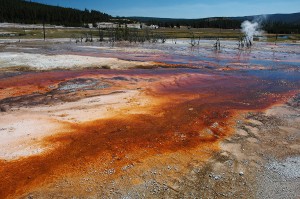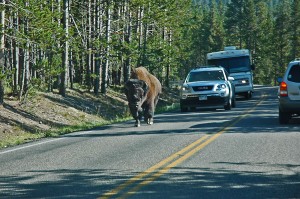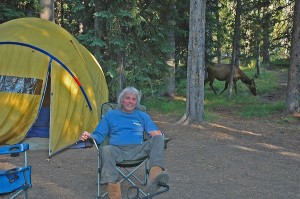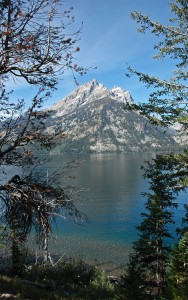Sitting here in front of my computer, with wind and rain pounding against the outside of the windows, I decided it was time to add a new element to the blog. Pam and I have spent time over the last four years visiting a number of our nation’s National Parks during the summer, and we’ve had some very excellent experiences we’d like to share. So here are some of our recommendations for visiting a few of these many wonderful places in western North America.
Planning your visit is part of the adventure. Start with a computer search. Just type in National Parks, USA, and you’re on your way. These beautiful scenic places are documented on the web in great detail. There’s a ton of information on the best time to visit, how to get there, options on where to stay, and things you can expect to see, including the flora and fauna of the area.
Yellowstone National Park
We love this park because of the thermal vents and the wildlife. There are over 300 active geysers in the park not counting other thermal features. It would take days to visit all of these, so depending on the length of your visit,  I recommend you start with the obvious visit to the information center next to “Old Faithful,” which erupts about every 90 minutes, and go from there. Thermal activity abounds in this, the largest active caldera in the states, and the opportunities to view these phenomena are endless. We usually allot a full day or more to this general area and enjoy every minute of it.
I recommend you start with the obvious visit to the information center next to “Old Faithful,” which erupts about every 90 minutes, and go from there. Thermal activity abounds in this, the largest active caldera in the states, and the opportunities to view these phenomena are endless. We usually allot a full day or more to this general area and enjoy every minute of it.
Yellowstone is also home to more animals than practically anywhere else in the lower 48. Free-roaming wildlife, especially in the Hayden Valley, is usually accessible for viewing right off the road that runs through the center of the park, and we’ll often drive its length more than once during the trip. You can also take in The Grand Canyon of Yellowstone, which is also located along this road. That’s another day well spent. Here’s a hint here for you to think about.  People driving this road are crazy. It they see an animal, any animal, they’ll stop, sometimes even in the middle of the road. This is a minor annoyance; however, it also alerts you to be ready for that special camera moment. Keep your camera ready and at hand everywhere you go, even when driving. Most animals in the park are used to people, and not shy about posing. Still, read the regulations about approaching wildlife, and stay safe. A telephoto lens is recommended. Oh! And don’t be fooled. Once we stopped in a long line of cars, and the people gathered there told us there was a wolf out there. But when we hurriedly parked and rushed out to have a look, the ‘wolf’ was wearing coyote clothing.
People driving this road are crazy. It they see an animal, any animal, they’ll stop, sometimes even in the middle of the road. This is a minor annoyance; however, it also alerts you to be ready for that special camera moment. Keep your camera ready and at hand everywhere you go, even when driving. Most animals in the park are used to people, and not shy about posing. Still, read the regulations about approaching wildlife, and stay safe. A telephoto lens is recommended. Oh! And don’t be fooled. Once we stopped in a long line of cars, and the people gathered there told us there was a wolf out there. But when we hurriedly parked and rushed out to have a look, the ‘wolf’ was wearing coyote clothing.
There are twelve major rivers in the park, so if you’re interested in water sports or fishing it’s definitely available. There are also a number of fishable lakes holding trophy trout.  You can drive to many of these or reach them trail walking. Because the park is over 60 miles long and 50 miles wide, and about five percent of that area is water, you can spend lots of time on the water enjoying your favorite sports. Be sure to check the regulations before you head out as fishing areas and limits can change frequently based on current conditions.
You can drive to many of these or reach them trail walking. Because the park is over 60 miles long and 50 miles wide, and about five percent of that area is water, you can spend lots of time on the water enjoying your favorite sports. Be sure to check the regulations before you head out as fishing areas and limits can change frequently based on current conditions.
 We love to camp on our trips, and we highly recommend Grant Campground. There are other campgrounds in the park, but this is our favorite. There’s a store and restaurants close by, and a really great hot-showers facility so you can wash off the trail grime at the end of the day. On our last trip a number of elk joined us at camp during happy hour, and a single fox was prowling around foraging in the morning.
We love to camp on our trips, and we highly recommend Grant Campground. There are other campgrounds in the park, but this is our favorite. There’s a store and restaurants close by, and a really great hot-showers facility so you can wash off the trail grime at the end of the day. On our last trip a number of elk joined us at camp during happy hour, and a single fox was prowling around foraging in the morning.
On one trip we wanted to visit the Grand Teton National Park too, including Jackson Hole, so we stayed at a commercial campground called the Flagg Ranch Resort that is situated conveniently between Grand Teton and Yellowstone.  There’s an upscale restaurant and hot showers available on site, and we enjoyed hearing the wolves in this area howl at night. The Snake River borders the campground if you also want to fish. This spot is slightly more expensive, but very comfortable. We recommend it, too.
There’s an upscale restaurant and hot showers available on site, and we enjoyed hearing the wolves in this area howl at night. The Snake River borders the campground if you also want to fish. This spot is slightly more expensive, but very comfortable. We recommend it, too.
This is one National Park no one should miss, and if you’ve already been here I’m sure you’ll agree. If you haven’t visited Yellowstone, well what can I say? I highly recommend that you plan to come to this park in the near future, I’m sure you won’t be disappointed.
(More to follow)

